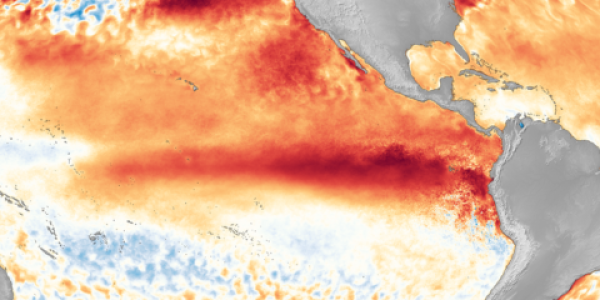NCEI data help scientists detect and monitor El Niño and La Niña and global ENSO impacts

El Niño has arrived and is likely to strengthen through the North Hemisphere Winter 2023-2024. Learn more about ENSO and how NCEI data helps to track El Niño and its impacts.
What is ENSO?
El Niño-Southern Oscillation, also known as ENSO, is a climate phenomenon that influences ocean currents, weather patterns, and even temperatures across the globe. ENSO has different phases and detecting those involves both observing sea-surface temperatures and detecting signature atmospheric patterns (known as the Southern Oscillation Index). The ENSO phase can be El Niño (warm), La Niña (cool), or neutral, and swings between these in cycles that can last two to seven years. Detecting and understanding the correct ENSO phase is key to responding effectively and promptly to global changes that can have significant impact on people, ecosystems, and agriculture.
Why is this phenomenon called El Niño? El Niño usually reaches full strength around the end of the calendar year, and the unusually warm waters and impacts peak in equatorial Pacific South America around the same time. This coincided with the Christmas holiday celebrating the birth of Jesus Christ (known as El Niño in Spanish), so early Christian inhabitants of tropical South America termed the phenomenon El Niño.
El Niño
For El Niño, scientists look for unusually warm waters in the Pacific Ocean near the equator, particularly in the area close to South America. The signature atmospheric pattern that indicates the arrival of El Niño is the weakening of normal easterly trade winds in the Pacific. Those winds that would typically push warmer surface waters towards Asia weaken and enhance the “build-up” of warmer water in the eastern and central Pacific Ocean. This leads to a large-scale increase of rising motion in the atmosphere over these warmer-than-average waters.
La Niña
La Niña, or the “cool” phase of ENSO, has a sea surface temperature signature that is roughly opposite that of El Niño, or unusually cool water along the equatorial Pacific. In the atmosphere, the easterly trade winds in the tropical Pacific are enhanced, increasing upwelling of colder water along the equator near South America and inducing/enhancing La Niña. This also results in a large-scale decrease of rising motion in the atmosphere over these cooler-than-average waters.
Oceanic and Atmospheric Observations Detect ENSO
As NOAA’s premier environmental data center, numerous products and data from NCEI are vital to detection of both El Niño and La Niña. One way the ENSO phase is diagnosed is by using observations of sea surface temperatures in different regions of the equatorial Pacific Ocean. Sea surface temperature departure from normal in the “Niño 3.4” region, also known as the Ocean Niño Index (ONI) is one of the key variables that can determine the ENSO phase and its intensity. Sea surface temperature anomalies are calculated by using NCEI’s Extended Reconstructed Sea Surface Temperature (ERSST) product.
Sea surface temperatures are also monitored via TAO/TRITON buoys that sit in a configuration in the equatorial Pacific Ocean that allows for quick detection of SST fluctuations that could indicate changes in ENSO phase.
Changes in equatorial sea surface temperature during both the cool and warm phases of ENSO are coupled with atmospheric changes, one of which that is easily measured is the change in Outgoing Longwave Radiation (OLR). During El Niño, the warmer equatorial SST causes an increase in atmospheric rising motion on a very large scale, causing clouds with much higher and colder cloud tops to move from the West Pacific to the Central Pacific. This results in lower OLR, detected via satellite, during El Niño. This “negative OLR” also signifies that the atmospheric portion of the ENSO warm phase has developed, and El Niño is likely occurring or will soon. The lower SST associated with the cool phase of ENSO decreases rising motion near the central/eastern tropical Pacific Ocean and therefore results in fewer clouds and lower and warmer cloud tops, creating a “positive OLR” and indicating the development or presence of La Niña.
These are just a few examples of the ways NCEI data and products help detect and diagnose ENSO phase.
NCEI ENSO-Related Products
NCEI also creates and maintains numerous products that relate to ENSO and its impacts on oceans, weather, and climate.
The 30-year U.S. climate normals are averages or “benchmarks” of temperature and precipitation that are used by sectors from emergency management to engineering, and NCEI produces a new set each decade. In order to account for fluctuations and trends in the U.S. climate, a different set of normals was released: ENSO normals. The U.S. ENSO Climate Normals take into account the influence of El Niño, La Niña, and climate change impacts. With the release of the 1991-2020 U.S. Climate Normals, a gridded version of the ENSO normals was created for easier access and interpretation by users.
Monthly and annual global climate reports produced by NCEI give global climate-related updates and describe ENSO impacts around the world.
The annual BAMS State of the Climate Report, published by the American Meteorological Society, details global climate information and provides a yearly look at global ENSO-related impacts. The lead editors of the report are NCEI scientists with authors from around the world, and includes input from dozens of NOAA-affiliated authors.
Influence on Global Weather and Climate
ENSO is one of the most significant climate oscillations to impact the globe. It affects ocean temperature and currents, atmospheric pressure, wind patterns, and rainfall amounts and location, to name a few. Impacts stretch across the globe, and are not just limited to the equatorial Pacific where the most obvious SST signatures and atmospheric pattern changes emerge.
Atmospheric changes related to ENSO can shift the locations of the world’s jet streams, impacting the tracks of weather systems and how far north/south warm/cool air is allowed to move. For example, in the U.S., certain trends in weather patterns become more or less likely depending on the ENSO phase. El Niño and La Niña typically peak in intensity during the winter, and so do weather-related impacts. El Niño winters can see the jet stream and storm track shifted farther south than normal over the U.S., increasing chances of cooler and wetter than normal conditions in the South and warmer, drier conditions in the Northeast and northern tier, including much of western Canada. La Niña winters often see a jet stream that is shifted northward, resulting in a greater likelihood of a drier and warmer South and wetter and cooler North.
Overall, El Niño years tend to be warmer globally, a trend which is documented in numerous NCEI data products and global climate reports.
ENSO phase is also factored into the seasonal tropical cyclone forecast for most ocean basins across the globe. For example, during El Niño in the Pacific Ocean, increased wind shear in the tropical Atlantic Ocean can tear disturbances apart before they are able to develop, increasing the chances of a less active than normal season in that basin. Conversely, increased SST in the equatorial Pacific makes a more active tropical season more likely in the East Pacific basin in an El Niño year. The seasonal expectation for the number of tropical systems switches basins during a La Niña year. Warmer SST and less wind shear than normal can make for a more active Atlantic hurricane season, while cooler than normal SST often results in an eastern Pacific hurricane season that is less active than usual.
Current Conditions and Forecast Information
With El Niño settling in and likely to intensify over the coming months, make sure to see the Climate Prediction Center for current information, forecasts and monthly updates. Regional Climate Centers will also periodically release outlooks discussing ENSO-related local climate impacts in regions around the U.S.






